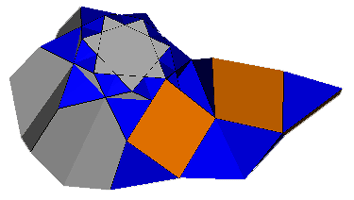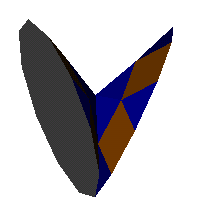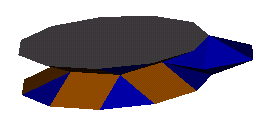



Generate a second
module identical to the first. The two figures can be attached by
their
rhombus shaped openings to form a closed polyhedron. Two
orientations
are possible. Either the two base polygons can have a point in
common ('ortho' mode),
or the base polygons can appear at opposite sides of the rhombus ('para'
mode).
A third option is to attach a 'pyramid' to the side of a 'cupola' (stage
1)
and then to join two such sections with their 'cupolas' together (stage
2) to form a 'meta'
mode).
The constructions gives the shapes a potential name (as suggested by
Alex
Doskey) of 'pairwise augmented cupolas'.
5-4-3 acrohedra
ortho-decatetradihedron,
meta-decatetradihedron,
para-decatetradihedron.
7-4-3 acrohedra
ortho-tetrakaidecahexadihedron
(exploded),
meta-tetrakaidecahexadihedron
(exploded),
para-tetrakaidecahexadihedron
(exploded).
9-4-3 acrohedra
ortho-octakaidecaoctadihedron,
meta-octakaidecaoctadihedron,
para-octakaidecaoctadihedron.
11-4-3 acrohedra
ortho-icosikaididecadihedron (image
above left),
meta-icosikaididecadihedron (image
above middle) and
para-icosikaididecadihedron (image
above right)
The para mode polyhedra can also exist in two isomorphous forms which are self intersecting. Examples for the 7-4-3 are linked here: Mode A and Mode B.
For the case of the 5-4-3 acrohedra only, it can also exist in two other alternate forms where a 'V' shaped gap from the top of the cupolaic segment is combined with a 'V' shaped gap from the side of said segment. Models are linked here: Mode C and Mode D
Thanks to Alex Doskey for pointing out the ortho and meta modes to me and for the alternate forms for the 5-4-3 acrohedra.
The 7-4-3 acrohedron and Mason Green's 7-7-3 acrohedron can be merged such that a 7-3-4-3 acron is formed. The solution has one pair of coplanar faces which can be resolved by the excavation of a tetrahedron to give the aplanar polyhedron shown above.
Unfortunately, attempting to create a 7-4-3-3 acrohedron by rotating the 7-4-3 acrohedron results in coplanar triangles at the vertex which cannot be resolved.
Using the same base elements as the 9-4-3 acrohedra above it is possible to generate further elementary polyhedra containing 9-4-3 acrons. Rather than placing a ring of triangles and squares around an enneagon to create one rhombus (above left), it is possible to create 3 equally spaced rhombi (above right)
Three of the original modules can then be added to this base, in two different ways, to create two distinct polyhedra containing 4 enneagons as above.
Connecting two of the new '3 rhombi' modules leaves four unconnected rhombi which can again be closed by the addition of the original '1 rhombus' modules to create a polyhedron containing 6 enneagons as above
These models are to my knowledge unique in that they are (a) elemental (b) non re-entrant and (c) contain more than two apolydronic polygons. A similar exercise for the 7-4-3 and 11-4-3 cases resulted in no solutions that were non re-entrant. Further exploration is though possible as rhombic prisms can be inserted between the modules.
More 7-4-3 acrohedra
Further 7-4-3 acrohedra occur among the facetings of the Self Augmented Heptagonal Semi-Cupola